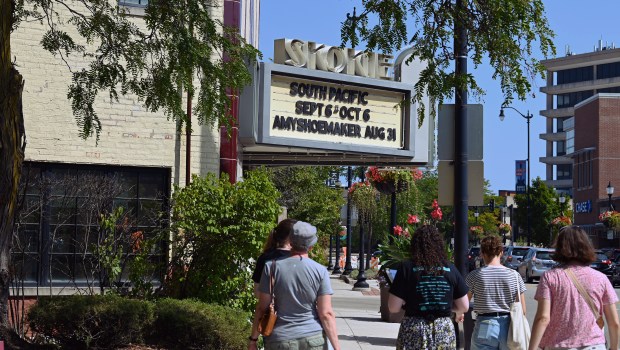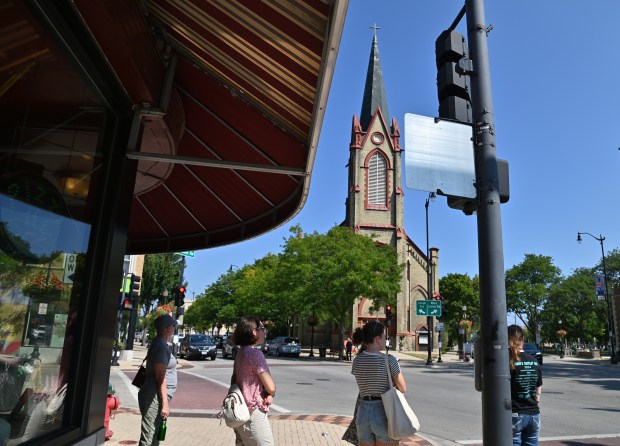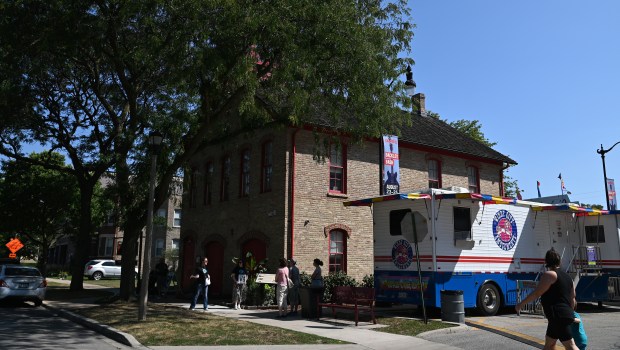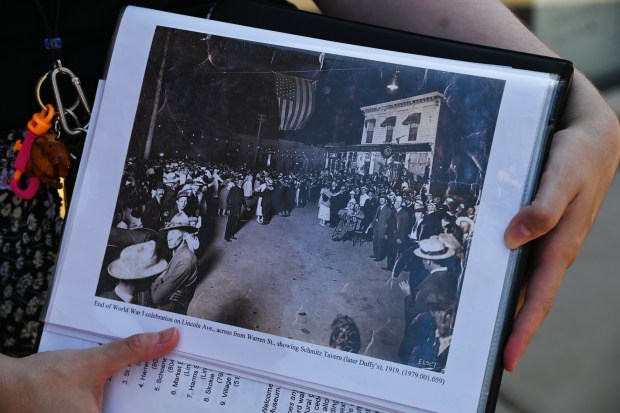The new Historic Downtown Skokie Walking Tour event on Sunday during Skokie’s Backlot Bash offered a glimpse into Skokie’s one-time flirtation with Hollywood, as well as other interesting tidbits about the past.
The one-hour tour, featuring a half-mile walk, began at the Skokie Heritage Museum at 8031 Floral Ave. and ended at Skokie Village Hall on Oakton Street along the event premises of Skokie’s Backlot Bash.
Sunday’s tour featured two guides, Museum Manager Emily England of Skokie and of the Skokie Heritage Museum and Stephanie Guthrie of Highland Park, the museum’s coordinator.
“It’s one of our shorter walks,” Guthrie said of the new highlights tour.
Of participants, “We have people who have just moved here a lot of the time who want to learn more about their community,” Guthrie said.“We also have people who have lived here their entire lives.”
England said, “We offer a handful of walking tours and since the museum is part of the Skokie Park District, we really want to offer more of them throughout Skokie because here we’re very downtown focused because this is where Skokie started, but Skokie has since expanded, and we want to tell more of the stories across the town.
“And as part of the park district, we want to promote people getting active, so walking tours are just a really good way to marry the park district’s activity focus and getting people out there and doing things, and then the history is educational,” England added.
Three people participated in Sunday’s tour, including Maddy Clowse of Chicago’s Buena Park neighborhood and Yudit Krupinski of Skokie.
“I’ve lived here my whole life so I want to learn something I didn’t know,” Krupinski said.
Clowse said, “I just moved to Chicago and I’m a city planner and I’m just trying to get to know more places around Chicago.”
At the beginning of the tour, participants were told what the word “Skokie” means.
The Potawatami word “wabskoki” means swamp or marshland.
After checking out of the 1847 log cabin (behind the firehouse museum) built by the Meyer family, who were of European descent and had 11 children), the tour took the walkers down Floral Avenue where greenhouses used to be.
Then it was a turn onto Brown Street, which has a tilted white frame building that could be coined as a literal “lean to.” The building leans because it wasn’t set properly, England said, on its foundation after the structure was rolled from a nearby corner in the early 1900s.

Then it was on to Lincoln Avenue where tour members heard about churches, the funeral home and the funeral home’s historic restored house next door. Lincoln Avenue has a storied history of social establishments.
“There’s a longtime saying that, ‘Skokie drinks Evanston’s water and Evanston drinks Skokie’s booze,’ because they (Evanston) were dry until the 70s,” England said with a smile.
Add to that, “Skokie used to look like the Wild West,” England said on Lincoln Avenue across from the Skokie theater building, built in 1915. The rugged look of Skokie was among reasons why Hollywood came calling to make silent films here in the early 1900s.
“With all the horses and buggies, and still the dirt roads, it looked perfectly like a Western (movie set),” England said.

Big celebrity names including Gloria Swanson frequented the movie backlots in Skokie but, “for a very brief moment, they even signed Charlie Chaplin,” England said.
“But after a month or two of winter in Chicago, he (Chaplin) was like, ‘No, no thank you, please.’
“And he canceled his contract and moved out to California,” England told the tour group.
“We (Skokie) can technically claim him (Chaplin) but not for very long.”
Skokie’s filming lore includes Niles East scenes in the 1984 John Hughes movie “Sixteen Candles” and a scene of the downtown in a television series episode of “Leave It to Beaver.”

Sunday’s tour continued to the busy intersection of Oakton Street and Lincoln Avenue where more history was shared.
This intersection was also busy many years ago, England said. A hotel sat on the southwest corner of Lincoln and Oakton circa the mid 1850s. A store, built in 1858, had a first post office and also a saloon and dance hall.
In September 1910, a fire broke out on a dry, windy market day and destroyed most of the business district. Pond water helped to eventually put out the fire, lighting a fire to the realization of an urgent need for a centralized water supply.

The last tour stop was at the second public building constructed in Skokie. Built in 1927, the Skokie Village Hall has a time-honored Independence Hall of Philadelphia look with its decorative columns.
“We are dedicated to sharing Skokie’s history,” England said, “and we want to preserve and share that information.”
Fo more information, visit https://www.skokieparks.org/skokie-heritage-museum/.



